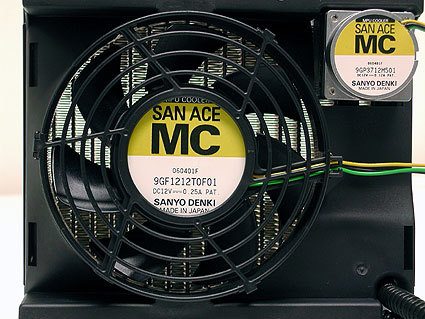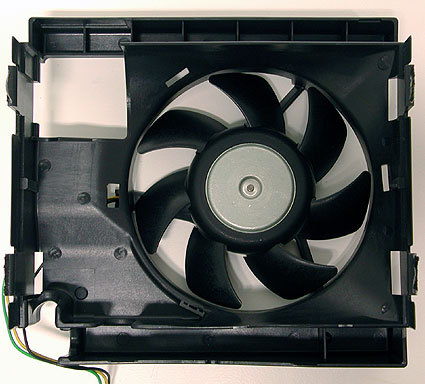Intel's CPU Heat Gets Watered Down
Impressions
If no fan header is available, you may also use a standard Molex adaptor.
The operating principle of Sanyo Denki's cooling system is simple: A little pump moves the liquid coolant through its loop. On one end of it, the liquid will pass a massive metal block that is installed onto the top of the processor, heating up by whose power loss. On the other side, the liquid passes a massive heat exchanger that is cooled by a large diameter fan, pushing the warm air out of the system.
First we noticed the low weight of the cooling solution. With only 1.24 kg, it is a lot lighter than most of its competitors, including internal or external versions. In contrast to most other solutions, the coolant is already poured into the circulation system, which is completely sealed. In addition, it does not require maintenance. As a result, users won't have to refill the cooling solution and the system is ready to use right from the start.
Installing the cooling block onto the processor socket is done within seconds and does not take more time than attaching Intel's reference boxed cooler. The system's installation is straightforward and simple, making it hard to go wrong.
As the mounting mechanism is both simple and precise, people won't be able to make mistakes.
At 38.3 dB (A), the Sanyo Denki device is significantly more quiet than the boxed cooler at 43.7 dB (A). In addition, the thermal resistance is at a low level of 0.37 K/W, beating all air cooling devices, but being only in the midfield in comparison to other liquid cooling solutions. However, considering its size, the results are pretty good.
This is the back side of the fan.
Get Tom's Hardware's best news and in-depth reviews, straight to your inbox.
Here we have the small pump that works pretty quietly.
The blades of the heat exchanges are pretty thin.
Current page: Impressions
Prev Page Cheaper And Easier Liquid Cooling For High-End CPU Heat Next Page Impressions, Continued
Patrick Schmid was the editor-in-chief for Tom's Hardware from 2005 to 2006. He wrote numerous articles on a wide range of hardware topics, including storage, CPUs, and system builds.




